
Ukraine without Kuchma was a mass protest campaign that took place in Ukraine in 2000–2001, demanding the resignation of President Leonid Kuchma, and preceding the Orange Revolution. Unlike the Orange Revolution, Ukraine without Kuchma was effectively extinguished by the government enforcement units, and followed by numerous arrests of the opposition and the Ukrainian-speaking participants. Seeking the criminal responsibility for those events was renewed with the election of Viktor Yanukovych as the President of Ukraine.
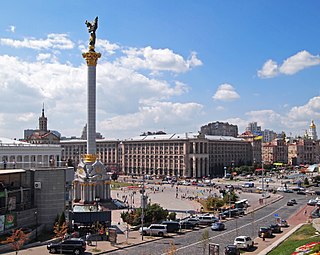
Maidan Nezalezhnosti is the central square of Kyiv, the capital city of Ukraine. One of the city's main squares, it is located on Khreshchatyk Street in the Shevchenko Raion. The square has been known under many different names, but often it is called by people simply Maidan ("square"). The square contains the iconic Independence Monument.
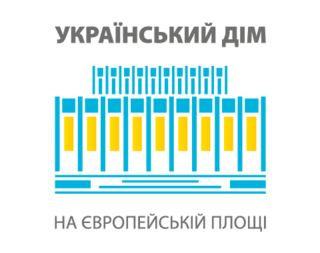
The Ukrainian House International Convention Center, is the largest international exhibition and convention center in Kyiv, Ukraine. The five-storey building is the host venue for a variety of events from exhibitions, trade fairs and conferences to international association meetings, product launches, banquets, TV-ceremonies, sporting events, etc.
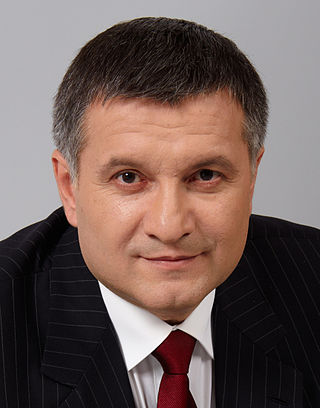
Arsen Borysovych Avakov is a Ukrainian politician and businessman. From 2014 to 2021 he was Ukraine's Minister of Internal Affairs, first being appointed in the first cabinet of Prime Minister Arseniy Yatsenyuk. He was reappointed to the same position in three successive governments, the last one being the Shmyhal Government formed in March 2020. His appointment caused massive protests in the country under the slogan "Avakov is the devil".

The rape of Iryna Krashkova, a 29-year-old woman, on 26 June 2013 by three men in the urban-type settlement of Vradiivka became a cause célèbre in Ukraine when anger at police for not arresting one of the suspects led to angry protests and the storming of the district police department on 1 July 2013.

Euromaidan, or the Maidan Uprising, was a wave of demonstrations and civil unrest in Ukraine, which began on 21 November 2013 with large protests in Maidan Nezalezhnosti in Kyiv. The protests were sparked by President Viktor Yanukovych's sudden decision not to sign the European Union–Ukraine Association Agreement, instead choosing closer ties to Russia and the Eurasian Economic Union. Ukraine's parliament had overwhelmingly approved of finalizing the Agreement with the EU, but Russia had put pressure on Ukraine to reject it. The scope of the protests widened, with calls for the resignation of Yanukovych and the Azarov government. Protesters opposed what they saw as widespread government corruption, abuse of power, human rights violations, and the influence of oligarchs. Transparency International named Yanukovych as the top example of corruption in the world. The violent dispersal of protesters on 30 November caused further anger. Euromaidan led to the 2014 Revolution of Dignity.

The Vladimir Lenin monument in Kyiv was a statue dedicated to Vladimir Lenin, the founder of the Soviet Union in Kyiv, the capital of Ukraine. The larger than life-size Lenin monument was built by Russian sculptor Sergey Merkurov from the same red Karelian stone as Lenin's Mausoleum. It was displayed at the 1939 New York World's Fair and erected on Kyiv's main Khreshchatyk Street on 5 December 1946.
Below are the domestic responses to the Euromaidan. Euromaidan was a wave of demonstrations and civil unrest in Ukraine that began on the night of 21 November 2013 after the Ukrainian government suspended preparations for signing an Association Agreement and Deep and Comprehensive Free Trade Agreement with the European Union.
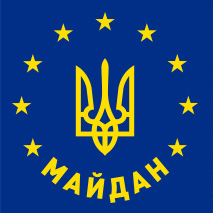
The Maidan People's Union is an alliance in Ukraine formed by several political parties and non-partisan individuals and public organizations on the fifth Sunday of the Euromaidan-protests with the aim of "building a new Ukraine and a new Ukrainian government" by creating a new Ukrainian constitution, and removing corrupt judges and prosecutors. It also aims to organize opposition to the current regime and to coordinate the protest movement in all regions of the country. In practice this means broadening support for the goals of the organization in the pro-government and pro-presidential heartland East Ukraine.

The Trade Unions Building, or Budynok Profspilok, is a large office building in Kyiv, Ukraine. Located on the city's main Khreshchatyk Street, its façade faces the central Maidan Nezalezhnosti square and contains the city's main clock tower.
The Vasylkiv terrorists case was an alleged terror plot of three far-right activists attempting to blow up a statue of Vladimir Lenin in the Ukrainian city of Boryspil in August 2011. The statue was removed in June 2011, before the alleged incident was supposed to take place. The three suspects were arrested on 22 August 2011.

In response to anti-protest laws in Ukraine, a standoff between protesters and police began on 19 January 2014 that was precipitated by a series of riots in central Kyiv on Hrushevsky Street, outside Dynamo Stadium and adjacent to the ongoing Euromaidan protests.

As part of the Euromaidan movement, regional state administration (RSA) buildings in various oblasts (regions) of Ukraine were occupied by activists, starting on 23 January 2014.

Maidan casualties, known in Ukraine as the Heavenly Hundred, are people who were killed during the 2014 Ukrainian Revolution of Dignity, part of the wider Euromaidan movement, and the early phase of the Russo-Ukrainian War. The list includes 130 identified individuals from both sides of the conflict who died during the events, including 18 police officers who were killed by protesters. The majority of those killed were civilians who supported the revolution.
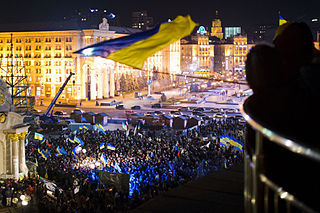
Euromaidan was a wave of demonstrations and civil unrest in Ukraine, which began on the night of 21 November 2013 with large public protests demanding closer European integration. Protesters also stated they joined because of the dispersal of protesters on 30 November and "a will to change life in Ukraine". The scope of the protests evolved over subsequent months, and by 25 January 2014 the protests were fueled by the perception of widespread government corruption, abuse of power, and violation of human rights in Ukraine. By February 2014 the protests had largely escalated into violence, resulting in the Revolution of Dignity and the resignation of Azarov's government and ousting of President Yanukovych. This resulted in the outbreak of the Russo-Ukrainian War.

Spilna Sprava is a political party in Ukraine registered on 19 March 2015, though active since late 2010. The name of the organisation, taken from Latin Res publica, indicates the republican nature of the movement, as well as symbolises the active civic solidarity of Ukrainians. It was founded in December 2010, during the Tax Maidan-2010 protests against the fiscal policies of Viktor Yanukovych.
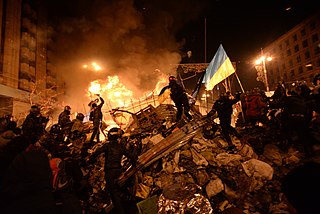
The Revolution of Dignity, also known as the Maidan Revolution or the Ukrainian Revolution, took place in Ukraine in February 2014 at the end of the Euromaidan protests, when deadly clashes between protesters and state forces in the capital Kyiv culminated in the ousting of elected President Viktor Yanukovych and a return to the 2004 Constitution. It also led to the outbreak of the Russo-Ukrainian War.

The anti-Maidan refers to a number of pro-Russian demonstrations in Ukraine in 2013 and 2014 that were directed against Euromaidan and later the new Ukrainian government. The initial participants were in favor of supporting the cabinet of the second Azarov government, President Viktor Yanukovych, and closer ties with Russia. By the time of the Revolution of Dignity in February 2014, the “anti-Maidan” movement had begun to decline, and after the overthrow of Yanukovych, the anti-Maidan fractured into various other groups, which partially overlapped. These ranged from people protesting against social ills, to supporters of a federalization of Ukraine, to pro-Russian separatists and nationalists.

The Revolution on Granite was a student-led protest campaign that took place primarily in Kyiv and Western Ukraine in October 1990. Ukraine was then the Ukrainian Soviet Socialist Republic, part of the Soviet Union until its declaration of independence from the Soviet Union on 24 August 1991. The protest was held from 2 October until 17 October 1990. One of the students' demands was the resignation of the Chairman of the Council of Ministers of the Ukrainian SSR Vitaliy Masol. On the last day of the protests, Masol was forced to resign and was replaced by Vitold Fokin.

























